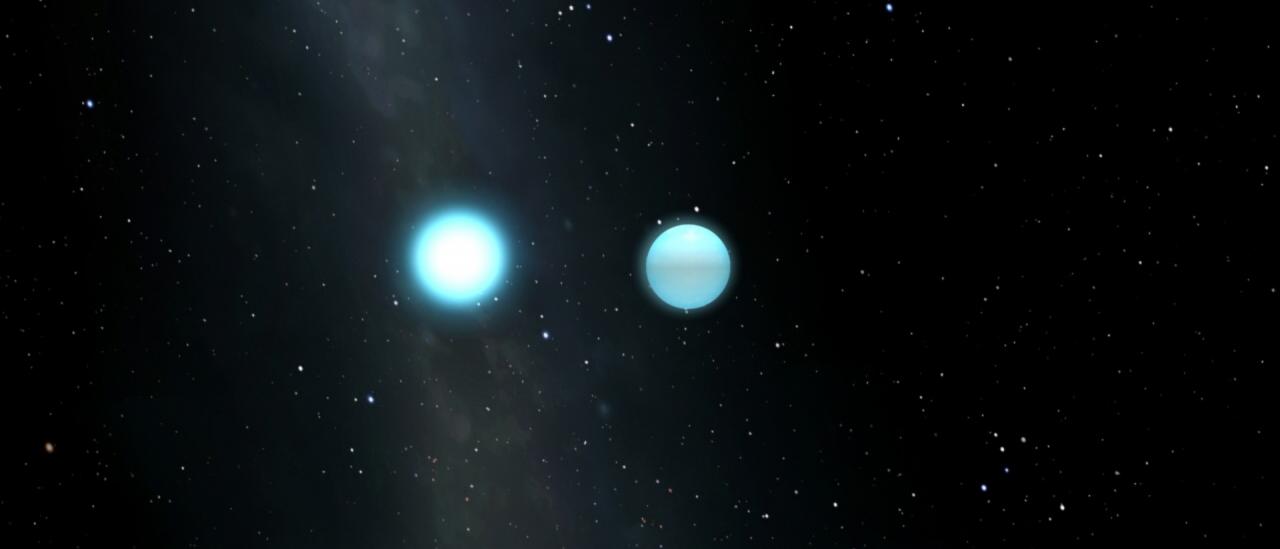An international research, led by scientists from the University of Sheffield and with the participation of the Instituto de Astrofísica de Canarias, has discovered, using the HiPERCAM instrument of the Gran Telescopio Canarias at the Roque de los Muchachos Observatory (Garafía, La Palma), an ancient pulsating star in a double star system. The discovery, which is published in the journal Nature Astronomy, provides important information about how stars like our Sun evolve and eventually die.
An international team of scientists, led by the University of Sheffield and with the participation of the Instituto de Astrofísica de Canarias, has discovered the first pulsating white dwarf star in an eclipsing binary system. This type of binary, or double star system, is made up of two stars orbiting each other and periodically passing in front of each other as seen from the Earth. One of the stars that form the observed system is a white dwarf, the burnt out cores left behind when a star like the Sun dies. This particular white dwarf could provide key insights into the structure, evolution and death of these stars for the first time.
Determining what a white dwarf is made of is not straightforward because these objects have about half of the mass of the Sun, packed into something about the size of the Earth. This means that gravity is extremely strong on a white dwarf, around one million times larger than here on Earth, so on the surface of a white dwarf an average person would weigh about 60,000,000kg.
"The gravity causes all of the heavy elements in the white dwarf to sink to the centre, leaving only the lightest elements at the surface and so the true composition of it remains hidden underneath", explains Steven Parsons, researcher in the University of Sheffield’s Department of Physics and Astronomy, who led the study.
To research the hidden structure of the white dwarf, the scientists used different techniques.“This pulsating white dwarf we discovered is extremely important since we can use the binary motion and the eclipse to independently measure the mass and radius of this white dwarf, which helps us determine what it is made of", says Parsons.
Most white dwarfs are thought to be made primarily of carbon and oxygen, but this particular white dwarf is made mostly of helium. The team think this is a result of its binary companion cutting off its evolution early, before it got a chance to fuse the helium into carbon and oxygen.
"Even more interestingly, the two stars in this binary system have interacted with each other in the past, transferring material back and forth between them. We can see how this binary evolution has affected the internal structure of the white dwarf, something that we've not been able to do before for these kinds of binary systems”, points out the astrophysicist.
The scientists combined the study of eclipses with astrosismology, a technique that involves measuring how fast sound waves travel through the white dwarf. To observe the rapid and subtle pulsations of the star, they used HiPERCAM, a revolutionary high-speed camera developed by a team led by Vikram S. Dhillon, astrophysicist from the University of Sheffield and affiliated researcher with the IAC.
This instrument, mounted on the10.4m Gran Telescopio Canarias (GTC) of the Roque de los Muchachos Observatory (Garafía, La Palma), can take one picture every millisecond simultaneously in five different colours."This exciting scientific discovery would not have been possible without the combination of the great light-gathering power of the GTC combined with the high-speed, multi-colour capability of HiPERCAM".
The next step of the research is to continue observing the white dwarf to record as many pulsations as possible using HiPERCAM and the Hubble Space Telescope.
Article: Steven G. Parsons et al. "A pulsating white dwarf in an eclipsing binary". Nature Astronomy, March 2020. DOI:10.1038/s41550-020-1037-z
Contact:
Vikram S. Dhillon: vik.dhillon [at] sheffield.ac.uk (vik[dot]dhillon[at]sheffield[dot]ac[dot]uk)





